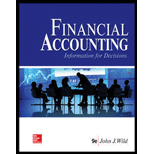
Describe how costs flow from inventory to cost of goods sold for the following methods: (a) FIFO and (b) LIFO.
a.
Inventory is a record of finished goods of a company which the can be sold to the customer, work in progress which can be transformed into finished goods and raw material which is a means of production. Inventory is also classified as current asset in the balance sheet and it is valued by FIFO, LIFO and weighted average method.
To determine: FIFO method of inventory accounting.
Answer to Problem 1DQ
FIFO method, the earliest inventories are documented as sold first
Explanation of Solution
FIFO method of inventory management stands for ‘first in first out’, means that the earliest inventory are documented as sold first but it does not mean that the same inventory has been sold first. At the time of sale the cost of earliest good acquired are reported in the financial statement. It will result in rest of the articles in the inventory being recorded for most latest incurred cost. It also result in the historical cost peered against current revenue. This mean profit margin does not reflect the proper matching of cost and revenue. As the costs of goods are increasing continuously the cost of earliest inventory will be of lower value. Lower cost of goods sold will result in higher net income. Higher net income will increase the profit margin ratio as profit margin ratio is calculated by dividing Net income by Net sales.
Introduction:
Inventory is a record of finished goods of a company which the can be sold to the customer, work in progress which can be transformed into finished goods and raw material which is a means of production. Inventory is also classified as current asset in the balance sheet and it is valued by FIFO, LIFO and weighted average method.
To determine: LIFO method of inventory accounting.
Answer to Problem 1DQ
LIFO method, the earliest inventories are documented as sold first
Explanation of Solution
LIFO method used to record inventory in the manner that the latest item is sold first. The cost of the most recent purchased item will be reported as cost of goods sold. So the older purchased item which has lower cost is reported in the inventory while the latest item which has highest cost is matched with sales in the financial statement. Issue with LIFO method is that it will use the cost of good from lasted purchase which will be highest so the net income will reduce. And lowest valued item will be recorded in current asset thus decreasing the current ratio.
Want to see more full solutions like this?
Chapter 5 Solutions
Loose Leaf for Financial Accounting: Information for Decisions
- A company had expenses other than the cost of goods sold of $280,000. Determine sales and gross profit given that the cost of goods sold was $120,000 and net income was $180,000.arrow_forwardaccounting?arrow_forwardI need assistance with this general accounting question using appropriate principles.arrow_forward
- What is the total manufacturing cost?arrow_forwardRachel is the stockholder and operator of Grand Dream LLC, a business coaching service. At the end of its accounting period, December 31, 2017, Grand Dream has assets of $825,000 and liabilities of $192,000. Using the accounting equation, determine the following amounts: a. Stockholders' equity as of December 31, 2017. b. Stockholders' equity as of December 31, 2018, assuming that assets increased by $128,000 and liabilities decreased by $42,000 during 2018.arrow_forwardPlease explain the solution to this financial accounting problem with accurate principles.arrow_forward
- Pluto Manufacturing reported the following: • • Direct labor: $7,500 Direct materials used: $3,000 Manufacturing overhead: $950 Cost of goods manufactured: $22,000 Ending work-in-process inventory: $2,200 What is the beginning work-in-process inventory?arrow_forwardProvide accurate answerarrow_forwardDirect materials:450, Direct labor:330arrow_forward
 Cornerstones of Cost Management (Cornerstones Ser...AccountingISBN:9781305970663Author:Don R. Hansen, Maryanne M. MowenPublisher:Cengage Learning
Cornerstones of Cost Management (Cornerstones Ser...AccountingISBN:9781305970663Author:Don R. Hansen, Maryanne M. MowenPublisher:Cengage Learning Managerial Accounting: The Cornerstone of Busines...AccountingISBN:9781337115773Author:Maryanne M. Mowen, Don R. Hansen, Dan L. HeitgerPublisher:Cengage LearningPrinciples of Accounting Volume 1AccountingISBN:9781947172685Author:OpenStaxPublisher:OpenStax College
Managerial Accounting: The Cornerstone of Busines...AccountingISBN:9781337115773Author:Maryanne M. Mowen, Don R. Hansen, Dan L. HeitgerPublisher:Cengage LearningPrinciples of Accounting Volume 1AccountingISBN:9781947172685Author:OpenStaxPublisher:OpenStax College Intermediate Accounting: Reporting And AnalysisAccountingISBN:9781337788281Author:James M. Wahlen, Jefferson P. Jones, Donald PagachPublisher:Cengage Learning
Intermediate Accounting: Reporting And AnalysisAccountingISBN:9781337788281Author:James M. Wahlen, Jefferson P. Jones, Donald PagachPublisher:Cengage Learning Intermediate Financial Management (MindTap Course...FinanceISBN:9781337395083Author:Eugene F. Brigham, Phillip R. DavesPublisher:Cengage Learning
Intermediate Financial Management (MindTap Course...FinanceISBN:9781337395083Author:Eugene F. Brigham, Phillip R. DavesPublisher:Cengage Learning




